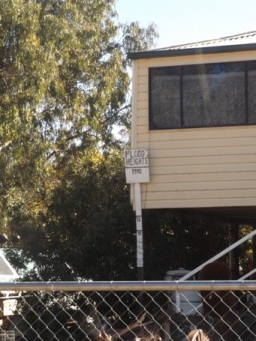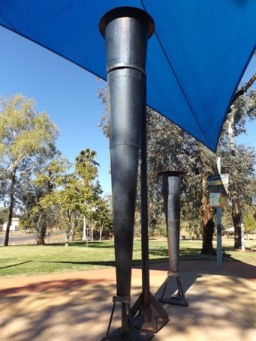Australia So Much to See
South Western Queensland - Charleville
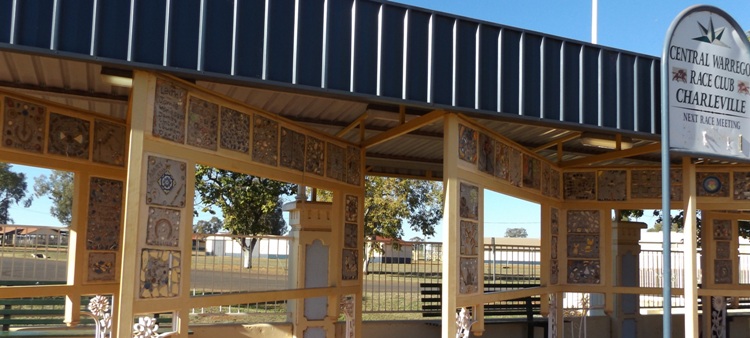
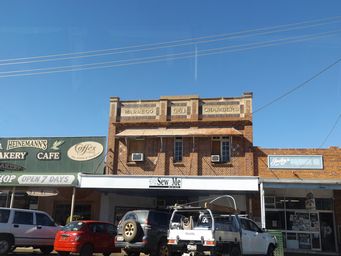
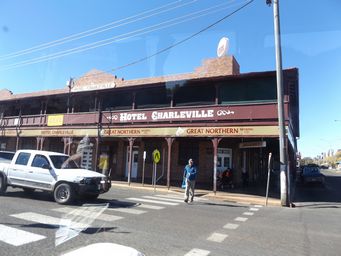
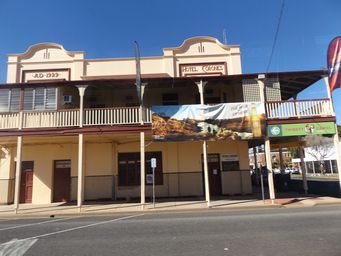
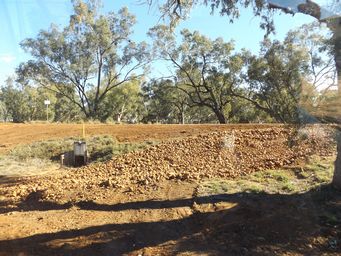
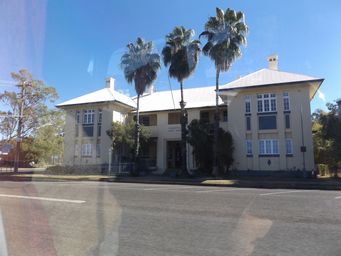
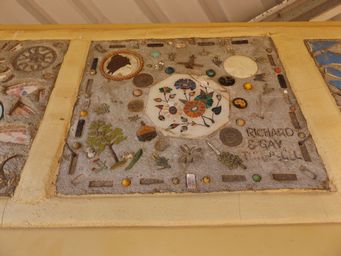
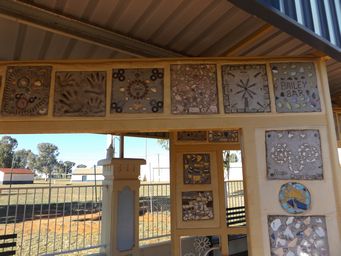
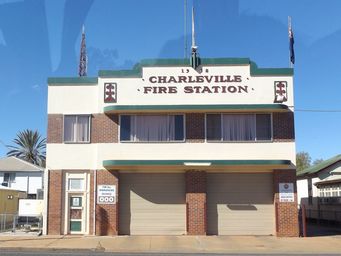
The town of Charleville has a population of around 3,600. It is the seat of the administration for the Shire of Murweh, which
means Big Water, and big water there has been through Charleville in flood years.
Our camp host Geoff takes bus tours
around Charleville and explains historical features, and tells details of the floods, droughts and fires the area has been prone to. This interesting and informative tour is available to visitors with pick up from the caravan parks. Floods have been recorded
many times since Charleville was founded, as have periods of drought.
Flood Events in Charleville in recent decades with height in metres
Feb 1956 6.55
Apr 1956 6.97
Apr 1990 8.54
Feb 1997 7.39
Jan 2004 5.29
Jan 2008 6.02
Mar 2010 6.65
An early industry was the Cobb and Co coach factory which was established in the town in 1886. One of five coach building factories
for Cobb and Co through the 1890s, all coach building was transferred to Charleville, where the drier climate was considered more
suitable for coach building. Due to the decline in needs for coaches due to the expansion of the railway network, this factory was
closed in 1920. This building burnt down in 1980. A caravan Park in Charleville bears the Cobb and Co name.
First Artesian bore was sunk in 1889. The artesian water which supplies the town has only a slight odour.
A protracted drought across much of the eastern side of Australia with low annual rainfalls occurred from 1895 to 1903. With little or no rain in 1901 and 1902, the people of Charleville tried a novel approach, hiring meteorologist Clement Wragge who had a plan that firing a number of Stiger Vortex guns into the sky would be enough to change to air pressure and cause rain.
Six
guns were set up strategic distances apart and fired at two minute intervals on 26th September 1902. The experiment failed but
rain was received in December that year, breaking the drought for the people of Charleville. Two of these tall upright guns
have been preserved and placed in the Graham Andrews Parklands with plaques telling the story.
During the war years of 1942 to 1946, the airport was handed over to the US Airforce for a large base which would be out of reach
of Japanese bombers which would be unable to fly so far and back on a tank of fuel. Around 3,500 personnel were housed here,
doubling the population of Charleville. With around a hundred buildings the occupancy was said to cover 25 square kilometres. There
were up to 250 planes at the base. This airbase was kept secret, and much of the area was camouflaged using chicken wire which
supported branches to appear from the air like the surrounding bushlands.
The top-secret site was selected to test the Norden bomb sight - a mechanical device that would attach to the Flying Fortresses to increase bombing accuracy - which meant it was rarely even referenced in war documents.
Ref: Discovering Charleville’s wartime secrets
The last remaining hangar is now used by the
Royal Flying Doctor Service. Tours of the relics on this developing new tourism feature can be booked through the Cosmos centre.
The worst recorded flood in Charleville occurred in 1990, when the river flowed at a rate of 41 kilometres per hour. This was
as a result of heavy rainfall in central Queensland, including in the Warrego River catchment area. Main tributaries of the
Warrego are the Ward, Langlo and Nive rivers. The Warrego River tributaries are sourced from the eastern side of the Carnarvon
Range. The Carnarvon Range forms a divide for rivers that run north and east as well as to the south. This was the same weather
event that flooded Nyngan in New South Wales in 1990.
The speed and amount of water took Charleville residents by surprise
as levee banks were breached overnight. Over 1,000 homes were inundated and many more affected, and the entire town population
was evacuated to the airport and the racecourse. Floodwaters reached halfway up the shops. Damage was estimated at $75
million.
Following this flood, government provided low interest loans for people to lift their houses, which would cost
around $80,000. Perhaps there were more reasons than cooling for “Queenslanders”, houses high above the ground on extended stumps.
Subsequently $300,000 was spent on levies along the gully and the river for flood mitigation. Flood gates (when shut) enabled
water in Bradley’s Gully to be kept out of town, or alternatively (if open) to release the gully water. The levees banks were
successful in keeping flood waters out of the town in 2012.
1997 saw the second worst flood in Charleville result in $30 million damages.
Following the 2004 floods, in 2005 levee banks were constructed, but the materials proved porous when flooding occurred in 2008.
In 2010 the town again saw flooding;
this time following localised rain when Bradley’s Gully through the town flooded when it could not escape into the river quickly enough. 1,200 of the town’s 1,500 houses were damaged.
The house above right is on high stumps, yet the 1990 flood still came a significant amount further than the rooms themselves.
In 1992 a skywatch observatory was set up, with Charleville being chosen due to its location being considered the best for clear skies
and year round observation. In 2003 this was further developed to become the Cosmos Centre, for which Charleville is now well
known.
With day and night programmes, the favoured night sky must be booked due to popularity. Weather permitting,
the programme runs nightly from April to October, and warm clothes must be worm as the air gets very cold. Less frequent viewings
are run during the warmer months, and may be subject to minimum numbers booking.
We enjoyed a fascinating evening looking
at first at the night sky when the observatory roof is opened, then we looked at selected features through at telescope, including
Jupiter and Saturn. Everyone is given an opportunity to use the telescopes, while guides ensure that you can see the subject
being viewed at that time. We were then shown how to find south using the Southern Cross.
The racecourse entrance has been enhanced with plaques following a substantial grant which enabled workshops for businesses, families
and schoolchildren to create these plaques. The racecourse adjoins the showgrounds, sportsgrounds, polocrosse grounds, a boxing
pavilion and a gymnasium.
Many buildings in Charleville have been subject to fires over the years. With the cost of freight, timber was extensively used
as a building material, and this cause fire readily, often attributed to electrical faults. Hotels and other businesses in particular
have been lost to fires, and due to replacement costs were rebuilt again using timber, so on some occasions were burnt down again. Even the Fire Station has burnt down. In 1938 a brick fire station was built. State government funding has been promised
for a new $1.3 million fire station to be constructed across the road from the present building which is unable to accommodate the
size of modern fire trucks. This will incorporate training areas and the technology now used for incident control.
Some of the larger fires included these events: In 1897 a fire which started in Hawkins Store also destroyed the adjacent
Telegraph Hotel. In 1931, a fire started in the Charleville Hotel, which quickly spread to adjoining buildings due to a strong
wind. The nearby relatively new brick Council Chambers helped arrest the blaze, but many buildings in the town centre were lost. As recently as 2011, the historic Railway Hotel burnt down.
Subsequent to our visit the new fire station was constructed, and was completed
and in use during March 2018.
Many early buildings have been retained in the town centre. Courthouse at right.
The present court house was completed in 1938, the year in which a new police station was built in Charleville. Designed by Public Works architect Raymond Nowland. The town’s first purpose-built court house was erected in 1900 by the Public Works Department. By 1937, as Charleville continued to develop as the government administration centre for the south-west, departments in town began to outgrow their existing accommodation and extensions were made to the early court house to provide rooms for the Lands Office staff, who were housed in another building. Ref: Local Heritage Places
Harry Corones came to Australia from Greece in 1900s, and arrived in Charleville in 1909. While running a business he was persuaded
to go into the hotel trade, and became licensee of the Hotel Charleville, which he rebuilt in timber following a fire in 1914. Selling
this in 1924, in 1926 he took over ownership of the Norman Hotel, and rebuilt as Hotel Corones, using fireproof masonry materials. The timber Hotel Charleville was again burnt down in 1931 and the present brick hotel was built. Ref: Wikipedia
